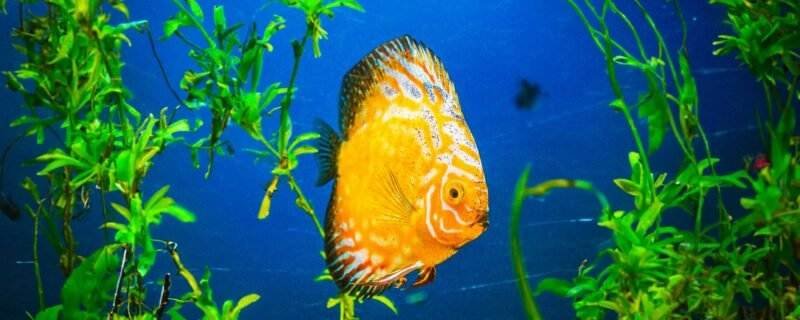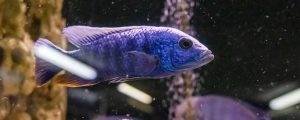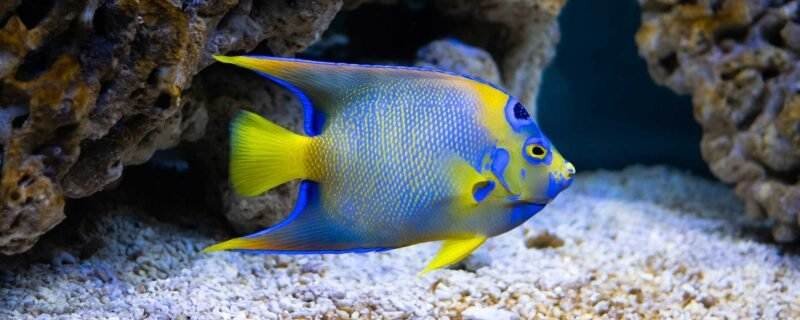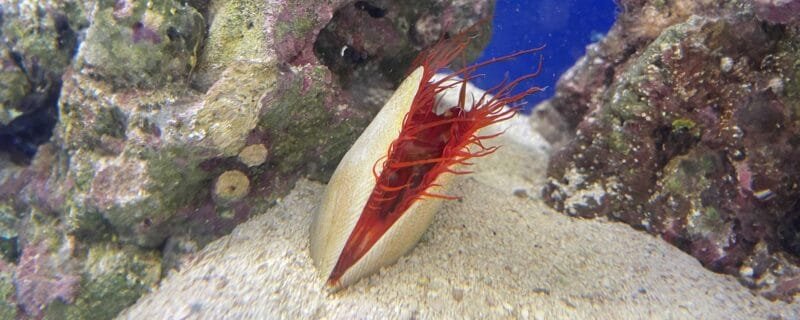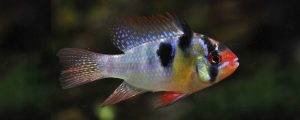The Dwarf Pike Cichlid, scientifically known as Crenicichla compressiceps, is one of the most intriguing and lesser-known members of the cichlid family. Often referred to simply as the “Dwarf Pike,” this fish brings the striking appearance and behavior of its larger relatives into a more manageable size for home aquariums. With its sleek, predatory body and intelligent eyes, this small but fierce fish is perfect for aquarists looking to add a touch of wild Amazon energy to their tanks—without the space requirements of full-sized pike cichlids.
Native Habitat
The Dwarf Pike Cichlid is native to the slow-moving and densely vegetated waters of the Amazon Basin, particularly around Brazil and nearby regions of South America. It is typically found in shallow tributaries, creeks, and flooded forest areas where submerged roots, leaf litter, and branches provide ample hiding places and ambush points for hunting.
These natural habitats have soft, acidic water and low mineral content, which is important to replicate in captivity to keep these fish comfortable and thriving.
Size and Appearance
As its name suggests, the Dwarf Pike Cichlid is smaller than most of its relatives in the Crenicichla genus.
-
Average Size: 3–4 inches (7–10 cm)
-
Maximum Size: Rarely over 5 inches (12 cm)
Despite its small size, the Dwarf Pike displays the sleek, torpedo-like body typical of pike cichlids. It features a pointed snout, large expressive eyes, and a distinctive dark lateral stripe running along its body. Males are usually more colorful and slightly larger, while females display a more muted tone but may have a noticeable spot or “ocellus” near the dorsal fin.
Coloration can vary based on mood, environment, and breeding condition but often includes earthy browns, olive greens, and subtle iridescence.
Diet
In the wild, Dwarf Pike Cichlids are micro-predators, feeding on small crustaceans, insect larvae, worms, and tiny fish. In captivity, they adapt well to a varied diet but require high-quality, protein-rich foods to maintain their health and coloration.
Recommended Diet:
-
Live foods: bloodworms, brine shrimp, daphnia, and small feeder guppies (occasionally)
-
Frozen foods: mysis shrimp, krill, and mosquito larvae
-
Prepared foods: high-quality cichlid pellets or frozen carnivore blends
They should be fed small portions 2–3 times daily, ensuring uneaten food does not remain, as this can quickly foul the water.
Sexing the Dwarf Pike Cichlid
Sexing Crenicichla compressiceps can be challenging until they mature.
Males:
-
Slightly larger overall
-
Longer fins with sharper tips
-
Brighter coloration when displaying or breeding
Females:
-
Rounder abdomen, especially when carrying eggs
-
May exhibit a black spot or patch near the dorsal fin base
Keeping a small group of juveniles and allowing them to pair off naturally is the most reliable method for establishing a breeding pair.
Breeding
Breeding Dwarf Pike Cichlids can be rewarding but requires attention to water quality and environmental setup. They are cave spawners, choosing tight crevices, tubes, or coconut shells as breeding sites.
Breeding Setup Tips:
-
Provide multiple caves or shelters to allow pair selection and reduce aggression
-
Maintain soft, acidic water (pH 6.0–6.5)
-
Keep temperatures between 78–82°F (25–28°C)
Once a pair forms, courtship involves body displays and subtle fin movements. Females lay 50–150 eggs, which are carefully guarded and fanned by both parents. Fry hatch in about 3 days and become free-swimming after another 4–5 days. At this stage, they can be fed freshly hatched brine shrimp and finely crushed flake foods.
Water Conditions
Maintaining proper water parameters is key to keeping Dwarf Pike Cichlids healthy.
Ideal Water Conditions:
-
Temperature: 76–82°F (24–28°C)
-
pH: 5.5–7.0
-
Hardness: Soft to moderately soft (1–8 dGH)
-
Tank Size: Minimum 30 gallons for a pair
They prefer a well-oxygenated tank with moderate water flow, dense vegetation, and multiple hiding spots using driftwood, rocks, or caves. Dim lighting or floating plants can also help replicate their natural habitat and reduce stress.
Ease of Care
The Dwarf Pike Cichlid is moderately difficult to care for and is best suited for intermediate to advanced aquarists. They are sensitive to poor water conditions and sudden parameter changes. Regular maintenance—weekly water changes of 25–30% and good filtration—is essential.
Because of their semi-aggressive temperament, they are not ideal for beginners or highly social community setups. However, in a well-managed tank with compatible tankmates, they can display fascinating behaviors and become personable, recognizing their keeper during feeding times.
Community Compatibility
Dwarf Pike Cichlids can coexist with other robust, medium-sized fish that won’t fit into their mouths. Ideal tankmates include:
-
Peaceful but sturdy cichlids (e.g., Apistogramma, Laetacara, or Keyhole Cichlid)
-
Larger tetras (Bleeding Heart, Congo, or Emperor Tetra)
-
Corydoras catfish (ensure plenty of hiding spots)
-
Plecos or small Loricariids
Avoid small or timid species like neon tetras, guppies, or shrimp, which may be viewed as food. Also, keep only one pair per tank unless the aquarium is very large, as territorial disputes can arise.
Species Variations
There are over 90 recognized species within the Crenicichla genus, ranging from small “dwarf” forms to massive predatory types exceeding 12 inches. C. compressiceps is one of the smallest, making it a favorite among aquarists who love the look of pike cichlids but don’t have space for the larger species like Crenicichla lenticulata or Crenicichla saxatilis.
Albino Variation:
Albino Dwarf Pike Cichlids are exceptionally rare. They display a pale, creamy coloration with red or pink eyes. While less common in the trade, albino forms retain the same care requirements but are more sensitive to bright lighting and stress. They should be kept in slightly shaded environments with subdued light and plenty of cover.
Behavior and Temperament
Dwarf Pike Cichlids are territorial and inquisitive. They form strong pair bonds but may become defensive during breeding. While they aren’t as aggressive as their larger cousins, they still show a clear hierarchy and dominance displays. Providing adequate territory space and visual barriers helps reduce aggression.
With regular care and interaction, these fish often display intelligent behaviors—following movements outside the tank and even learning to take food from their keeper’s fingers.
Related Species
Some closely related and similar dwarf pike cichlids include:
-
Crenicichla regani – slightly larger, more widespread in trade
-
Crenicichla notophthalmus – another small Amazonian species
-
Crenicichla wallacii – small, colorful species often confused with C. compressiceps
These relatives share similar water and diet requirements but may vary in coloration and aggression levels.
FAQs About the Dwarf Pike Cichlid
1. Can Dwarf Pike Cichlids live in community tanks?
They can, but only with carefully chosen tankmates. Avoid small or timid fish, and ensure each fish has its own space and hiding spots.
2. How big do Dwarf Pike Cichlids get?
Adults typically grow to 3–4 inches, making them one of the smallest members of the Crenicichla genus.
3. Are Dwarf Pike Cichlids suitable for beginners?
Not really. They are best for aquarists with experience in maintaining stable water parameters and handling semi-aggressive species.
Conclusion
The Dwarf Pike Cichlid (Crenicichla compressiceps) offers aquarists the thrill of keeping a predatory cichlid in a compact, beautiful package. With their striking body shape, intelligent behavior, and fascinating breeding habits, they are a joy for those ready to meet their specific needs. In the right setup—soft water, stable conditions, and a peaceful environment—these fish can display natural hunting behaviors and even pair-bonded parenting unseen in most aquarium species.

